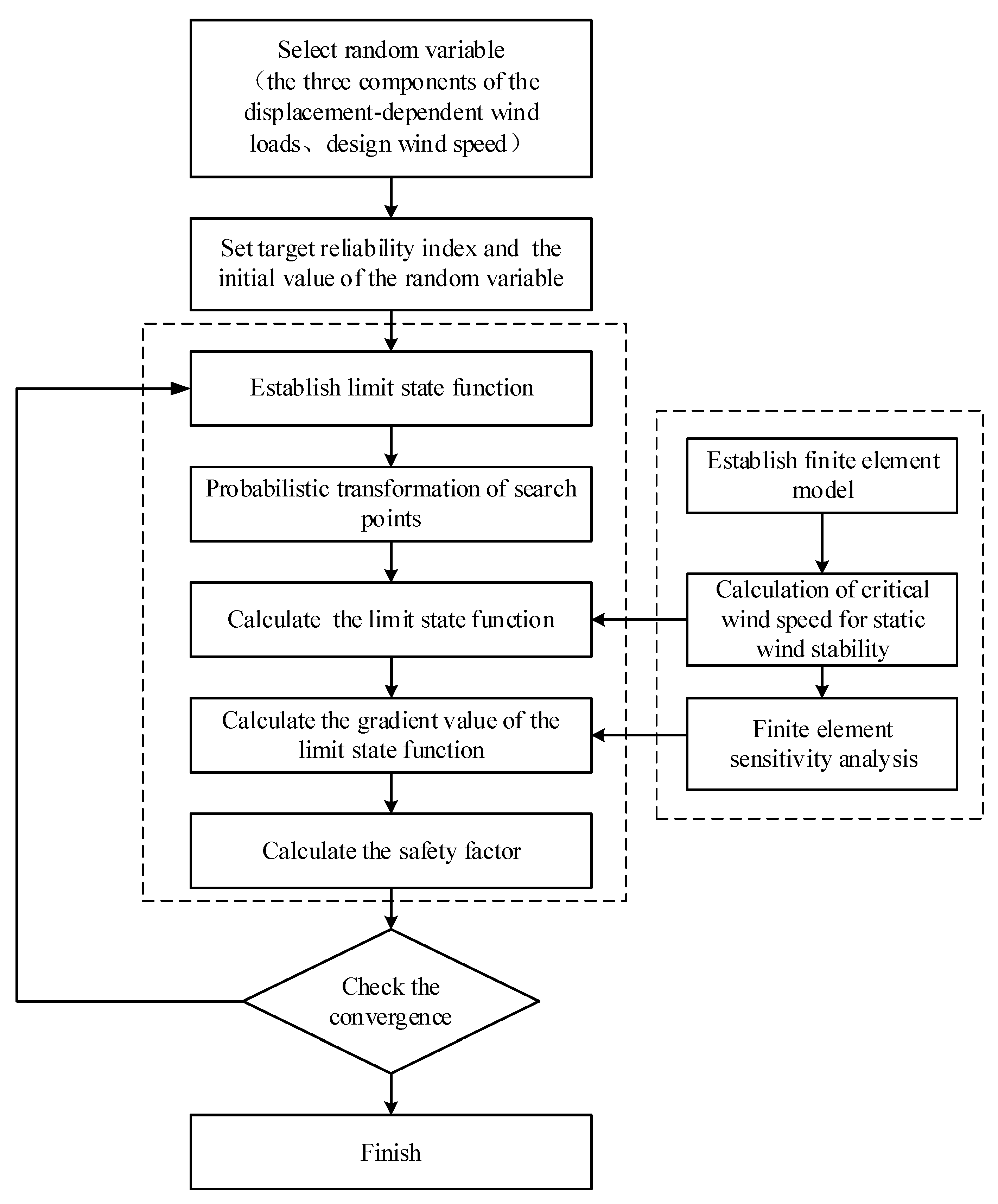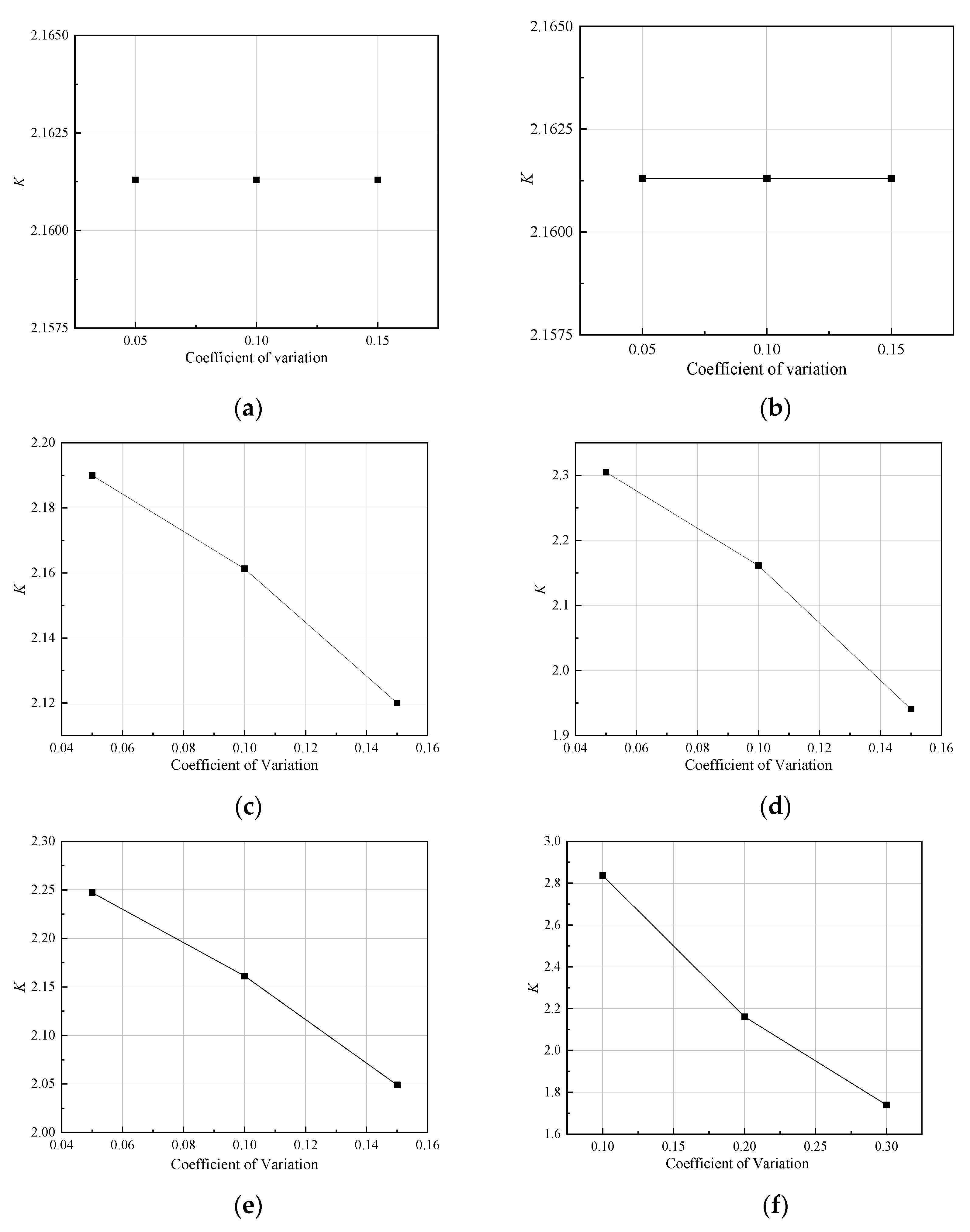Probabilistic Assessment Approach of the Aerostatic Instability of Long-Span Symmetry Cable-Stayed Bridges
Abstract
:1. Introduction
2. Probabilistic Evaluation Model of Aerostatic Wind Stability Safety
2.1. Selection of Random Variables
2.2. Establishment of the Limit State Equation
2.3. Selection of Random Variables
- (1)
- Determine the initial state of the cable-stayed bridge structure under a dead load, including its geometric shape, the dead load internal force, and the pretension forces in all the cables.
- (2)
- Set the initial wind speed V0.
- (3)
- Calculate the aerostatic wind load acting on the bridge structure.
- (4)
- The Newton–Raphson iterative method is used to solve Equation (4), and the current structure displacement is obtained.
- (5)
- The torsion displacement of the stiffened beam after deformation is determined by the structural displacement, and the corresponding aerostatic wind load is recalculated.
- (6)
- Check whether the Euclidean norm of the three components of the displacement-dependent wind loads on each node is less than the allowed value, as shown in the following Formula (5):
- (7)
- Increase the wind speed according to the predetermined step length if Formula (5) meets the requirements, and then repeat steps (3)–(5); Otherwise, repeat steps (4) and (5) for a new round of iterative calculation.
- (8)
- When the structure is close to instability, the incremental step of wind speed is appropriately reduced until the structure is unstable.
- (9)
- Output results.
3. Probabilistic Evaluation Method for Aerostatic Wind Stability Safety
3.1. Inverse Reliability Method Based on the Finite Element Method
3.2. Probabilistic Analysis Process of Aerostatic Wind Stability Safety
4. Case Analysis
4.1. Project Overview
4.2. Calculation of Critical Wind Speed for Aerostatic Wind Stability
4.3. Safety Factor Evaluation Equation
4.4. Determination of the Target Reliability Index
4.5. Probability Evaluation of Aerostatic Wind Stability Safety
4.6. Parameter Sensitivity Analysis
4.6.1. The Influence of the Target Reliability Index
4.6.2. Influence of Mean Random Variables
4.6.3. Influence of the Random Variable Variation Coefficient
4.6.4. Influence of Differential Calculation Step Size and Initial Value
5. Discussion
- (1)
- Combining the inverse reliability theory with the finite element method, a probabilistic evaluation method for aerostatic wind stability safety of long-span cable-stayed bridges is proposed. The finite element inverse reliability method based on FORM was used to analyze the reliability of the aerostatic wind stability of Sutong Bridge. The results showed that the probability aerostatic wind stability safety factor is 2.17 when the target reliability index is 3.5.
- (2)
- It is necessary to consider the influence of parameter randomness in the probabilistic evaluation of aerostatic wind stability safety of long-span cable-stayed bridges, and the method proposed in this paper can be used to evaluate the probabilistic evaluation of aerostatic wind stability safety of long-span cable-stayed bridges. The randomness of parameters has an important influence on the probabilistic aerostatic wind stability safety factor of Sutong Bridge.
- (3)
- The randomness of drag coefficient and lift coefficient has little influence on the probabilistic safety coefficient of aerostatic wind stability, while the randomness of pitch moment coefficient, critical wind speed conversion coefficient, gust factor and design wind speed has an important influence on the probabilistic safety coefficient of aerostatic wind stability. The differential calculation step has no influence on the accuracy of the calculation results of the probability aerostatic wind stability safety factor of Sutong Bridge.
- (4)
- In the practical engineering of long-span cable-stayed bridges, the pitch moment coefficient, critical wind speed conversion coefficient, gust factor and randomness of design wind speed can be controlled to ensure the stability and safety of aerostatic wind on long-span cable-stayed bridges.
Author Contributions
Funding
Institutional Review Board Statement
Informed Consent Statement
Data Availability Statement
Acknowledgments
Conflicts of Interest
References
- Zhang, Y.; Wei, Y.; Bai, J.; Wu, G.; Dong, Z. A novel seawater and sea sand concrete filled FRP-carbon steel composite tube column: Concept and behaviour. Compos. Struct. 2020, 246, 112421. [Google Scholar] [CrossRef]
- Ding, M.; Luo, B.; Han, L.; Shi, Q. Modelling and Structural Design for Parallel Umbrella-Shaped Cable-Strut Structures Based on Stationary Potential Energy Principles. Math. Probl. Eng. 2019, 2019, 1–24. [Google Scholar] [CrossRef] [Green Version]
- Huang, K.; Liu, J.; Wang, J.; Shi, X. Characterization and Mechanism of a New Superhydrophobic Deicing Coating Used for Road Pavement. Crystals 2021, 11, 1304. [Google Scholar] [CrossRef]
- Wei, Y.; Bai, J.; Zhang, Y.; Miao, K.; Zheng, K. Compressive performance of high-strength seawater and sea sand concrete-filled circular FRP-steel composite tube columns. Eng. Struct. 2021, 240, 112357. [Google Scholar] [CrossRef]
- Ding, M.; Luo, B.; Han, L.; Shi, Q.; Guo, Z. Optimal design of spoke double-layer cable-net structures based on an energy principle. Struct. Eng. Mech. 2020, 74, 533–545. [Google Scholar] [CrossRef]
- Wei, Y.; Zhao, K.; Hang, C.; Chen, S.; Ding, M. Experimental Study on the Creep Behavior of Recombinant Bamboo. J. Renew. Mater. 2020, 8, 251–273. [Google Scholar] [CrossRef]
- Huang, K.; Sun, Y.; Sun, S.; Zhang, X.; Lei, H. Physical properties of quaternary compounds Gd2CoAl4T2 (T = Si, Ge) single crystals. Front. Phys. 2018, 14, 23502. [Google Scholar] [CrossRef]
- Ding, M.; Luo, B.; Ding, S.; Shen, Y.; Huang, L. Experimental Investigation and Numerical Simulation of a Levy Hinged-Beam Cable Dome. Buildings 2021, 11, 110. [Google Scholar] [CrossRef]
- Wei, Y.; Tang, S.; Ji, X.; Zhao, K.; Li, G. Stress-strain behavior and model of bamboo scrimber under cyclic axial compression. Eng. Struct. 2020, 209, 110279. [Google Scholar] [CrossRef]
- Ding, M.; Shen, Y.; Wei, Y.; Luo, B.; Wang, L.; Zhang, N. Preliminary Design and Experimental Study of a Steel-Batten Ribbed Cable Dome. Symmetry 2021, 13, 2136. [Google Scholar] [CrossRef]
- Zhiwen, L.; Airong, C.; Shuanhai, H. Probabilistic finite element analysis of cable stayed bridges under wind. J. Chang’an Univ. 2004, 24, 53–57. [Google Scholar] [CrossRef]
- Yaojun, G. Wind Resistance of Long-Span Suspension Bridge; China Communications Press: Beijing, China, 2011. [Google Scholar]
- Xiufeng, L. Research on Reliability of Aerostatic Wind Response and Aerostatic Stability of Long-span Bridges; South China University of Technology: Guangzhou, China, 2008. [Google Scholar]
- Su, C.; Luo, X.; Yun, T. Aerostatic Reliability Analysis of Long-Span Bridges. J. Bridg. Eng. 2010, 15, 260–268. [Google Scholar] [CrossRef]
- Su, C.; Luo, J.; Xiao, C. Efficient Approach for Reliability Assessments on Aeroinstability of Long-Span Bridges. J. Bridg. Eng. 2013, 18, 570–575. [Google Scholar] [CrossRef]
- Cheng, J.; Jiang, J.-J.; Xiao, R.-C. Aerostatic stability analysis of suspension bridges under parametric uncertainty. Eng. Struct. 2003, 25, 1675–1684. [Google Scholar] [CrossRef]
- Cheng, J.; Li, Q. Application of the response surface methods to solve inverse reliability problems with implicit response functions. Comput. Mech. 2008, 43, 451–459. [Google Scholar] [CrossRef]
- Cheng, J.; Li, Q. Reliability analysis of long span steel arch bridges against wind-induced stability failure. J. Wind. Eng. Ind. Aerodyn. 2009, 97, 132–139. [Google Scholar] [CrossRef]
- Cheng, J.; Li, Q. Reliability analysis of a long span steel arch bridge against wind-induced stability failure during construction. J. Constr. Steel Res. 2009, 65, 552–558. [Google Scholar] [CrossRef]
- Cheng, J.; Li, Q. Reliability based analysis of torsional divergence of long span suspension bridges. Wind. Struct. Int. J. 2009, 12, 121–132. [Google Scholar] [CrossRef]
- Palaniappan, R.; Qu, X.Y.; Youn, B.D. Safety factor and inverse reliability measures. In Proceedings of the Collection of Technical Papers-AIAA/ASME/ASCE/AHS/ASC Structures, Structural Dynamics & Materials Conference, Palm Springs, CA, USA, 19–22 April 2004; pp. 1745–1755. [Google Scholar] [CrossRef]
- Cheng, J.; Cai, C.S.; Xiao, R.-C. Estimation of cable safety factors of suspension bridges using artificial neural network-based inverse reliability method. Int. J. Numer. Methods Eng. 2006, 70, 1112–1133. [Google Scholar] [CrossRef]
- Cheng, J.; Xiao, R.C. Main Cable Safety Factors Assessment of Long-span Suspension Bridges Based on Inverse Reliability Method. Chin. J. Highw. Transport 2007, 20, 58–61. [Google Scholar] [CrossRef]
- Jiang, W. Reliability Analysis and Safety Factor Assessment for Stability of CFST Arch Ribs. Ph.D. Thesis, Harbin Institute of Technology, Harbin, China, 2014. [Google Scholar]
- Jiang, W.; Lu, D.G. Stability design of concrete filled steel tubular arches using inverse finite element reliability method. J. Build. Struct. 2013, 34, 119–124. [Google Scholar] [CrossRef]
- Lou, C.H.; Dong, F.H. Study of overturning stability safety factors of continuous girder bridges during cantilever Lou con-struction. Eng. J. Wuhan Univ. 2017, 50, 264–268. [Google Scholar] [CrossRef]
- Liu, J.; Yang, J.X.; Dong, F.H. Safety Factors Assessment of Resistant Overturning Stability of Long-span Continuous Girder Bridges in Cantilever Construction. Chin. J. Highw. Transp. 2018, 31, 89–95. [Google Scholar] [CrossRef]
- Jin, H.; Zhu, Y.B.; Xu, Y. Stability analysis of the continuous rigid frame bridge based on inverse reliability method. J. Railw. Sci. Eng. 2018, 15, 421–426. [Google Scholar] [CrossRef]
- Cheng, J.; Dong, F. Application of inverse reliability method to estimation of flutter safety factors of suspension bridges. Wind. Struct. Int. J. 2017, 24, 249–265. [Google Scholar] [CrossRef]
- Liu, F.; Wang, L.; Jin, D.; Liu, X.; Lu, P. Equivalent Beam Model for Spatial Repetitive Lattice Structures with Hysteretic Nonlinear Joints. Int. J. Mech. Sci. 2021, 200, 106449. [Google Scholar] [CrossRef]






| Random Variables | Distribution Type | Mean | Standard Deviation | Coefficient of Variation | Sources |
|---|---|---|---|---|---|
| Normal | 1 | 0.1 | 0.1 | [4,5] | |
| Normal | 1 | 0.1 | 0.1 | [4,5] | |
| Normal | 1 | 0.1 | 0.1 | [4,5] | |
| Normal | 1 | 0.1 | 0.1 | [2] | |
| Normal | 1.18 | 0.12 | 0.1 | [2] | |
| Extreme type I | 20.26 | 4.05 | 0.2 | [11,12] |
| Target Reliability Index | 2.5 | 3.0 | 3.5 | 4.0 |
| Safety Factor | 2.92 | 2.48 | 2.17 | 1.91 |
Publisher’s Note: MDPI stays neutral with regard to jurisdictional claims in published maps and institutional affiliations. |
© 2021 by the authors. Licensee MDPI, Basel, Switzerland. This article is an open access article distributed under the terms and conditions of the Creative Commons Attribution (CC BY) license (https://creativecommons.org/licenses/by/4.0/).
Share and Cite
Dong, F.; Shi, F.; Wang, L.; Wei, Y.; Zheng, K. Probabilistic Assessment Approach of the Aerostatic Instability of Long-Span Symmetry Cable-Stayed Bridges. Symmetry 2021, 13, 2413. https://doi.org/10.3390/sym13122413
Dong F, Shi F, Wang L, Wei Y, Zheng K. Probabilistic Assessment Approach of the Aerostatic Instability of Long-Span Symmetry Cable-Stayed Bridges. Symmetry. 2021; 13(12):2413. https://doi.org/10.3390/sym13122413
Chicago/Turabian StyleDong, Fenghui, Feng Shi, Libin Wang, Yang Wei, and Kaiqi Zheng. 2021. "Probabilistic Assessment Approach of the Aerostatic Instability of Long-Span Symmetry Cable-Stayed Bridges" Symmetry 13, no. 12: 2413. https://doi.org/10.3390/sym13122413






